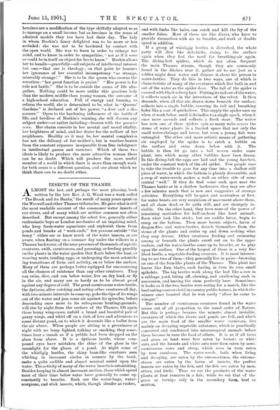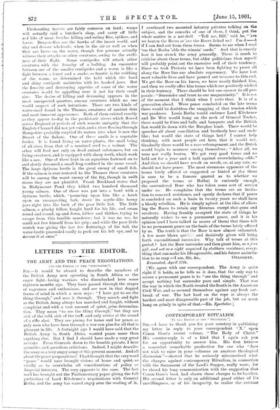INSECTS OF THE THAMES.
ALMOST the last, and perhaps the most pleasing, book written by the late Rev. J. G. Wood was a work called " The Brook and its Banks," the result of many years spent on the Werwell and other Thames tributaries. He gave what is still the most readable account of the commoner water insects of our rivers, and of many which are neither common nor often described. But except among the select few, generally either enthusiastic boys or London mechanics of an inquiring mind, who keep fresh-water aquariums and replenish them from ponds and brooks at " week-ends," few persons outside "the fancy " either see or know much of the water insects, or are aware, when floating on a summer day under the willows in a Thames backwater, of the near presence of thousands of aquatic creatures, swift, carnivorous, and pursuing, or feeding greedily on the plants in the water garden that floats below the boat, or weaving nests, tending eggs, or undergoing the most astonish- ing transitions of form and activity, on or below the surface. Many of them are perhaps better equipped for encountering all the chances of existence than any other creatures. They can swim, dive, and run below water, live on dry land, or fly in the air, and many are so hardy as to be almost proof against any degree of cold. The great carnivorous water-beetle, the dytiscus, after catching and eating other creatures all day, with two-minute intervals to come up, poke the tips of its wings out of the water and jam some air against its spiracles, before descending once more to its subaqueous hunting-grounds, will rise by night from the surface of the Thames, lift again those horny wing-cases, unfold a broad and beautiful pair of gauzy wings, and whirl off on a visit of love and adventure to some distant pond, on' o which it descends like a bullet from the air above. When people are sitting in a greenhouse at night with no lamp lighted, talking or smoking, they some- times hear a smash as if a pebble had been dropped on the glass from above. It is a dytiscus beetle, whose com- pound eyes have mistaken the shine of the glass in the moonlight for the gleam of a pond. At night some of the whirligig beetles, the shiny bean-like creatures seen whirling in incessant circles in corners by the bank, make a quite audible and almost musical sound upon the water. The activity of many of the water insects is astonishing. Besides keeping in almost incessant motion, those which spend most of their time below water have generally to come up constantly to breathe. Such are the water-bugs, water- scorpions, and stick insects, which, though slender as rushes,
and with limbs like hairs, can catch and kill the fry of the smaller fishes. Most of these are like divers, who have to provide themselves with air to breathe, and work at double speed in addition.
If a group of whirligig beetles is disturbed. the whole party will dive like dabehicks, rising to the surface again when they feel the need for breathing-air again. The diving-bell spiders, which do not often frequent the main Thames stream, though they are commonly found in the ditches near it, gather air to use just as a soldier might draw water and dispose it about his person in water-bottles. They do this in two ways, one of which is characteristic of many of the creatures which live both in and out of the water as the spider does. The tail of the spider is covered with black velvety hair. Putting its tail out of the water, it collects much air in the interstices of the velvet. It then descends, when all this air, drawn down beneath the surface, collects into a single bubble, covering its tail and breathing holes like a coat of quicksilver. This supply the spider uses up when at work below, until it dwindles to a single speck, when it once more ascends and collects a fresh store. The writer has seen one of these spiders spin so many webs across the stems of water plants in a limited apace that not only the small water-shrimps and larvm, but even a young fish were entangled. The other and more artistic means of gathering air employed by the spider is to catch a bubble on the surface and swim down below with it. The bubble is then let go into a bell woven under some plant, into which many other bubbles have been drawn. In this diving-bell the eggs are laid and the young hatched. under the constant watch of the old spider. Few people care to take the trouble to gaze for any time into a shallow still piece of water, in which the bottom is plainly discernible, and a crop of water-weeds makes a wall on either side of some central "well" If they do find some such spot near the Thames banks or in a shallow backwater, they may see after a few minutes much that is new and suggestive of strange activities. Everything will be quiet and motionless at first, for water beasts are very suspicious of movement above theni, and all sham dead, or lie quite still, and are strangely in- visible. On the other hand, they have none of the power of remaining motionless for half-an-hour like land animals. Soon what look like sticks, but are caddis larvte, begin to creep on the bottom. Then more brown objects, larvce of dragon-flies and water-beetles, detach themselves from the stems of the plants and cruise up and down seeking what they may devour. Other creatures feeding and swimming among or beneath the plants crawl out on to the upper surface, and the water-beetles come up to breathe, or to play upon the surface. One of the largest of these is a very fine black beetle, a vegetable-feeding creature. It is most interest- ing to see two of them—they generally live in pairs—browsing on one of the fern-like plants of the Thames. This plant has leaves like fern blades, each having in turn its own small spikelets. The big beetles work along the leaf like a cow in a cabbage yard, biting off, chewing, and swallowing each in succession, and leaving the stem perfectly bare. Sometimes it looks as if the two beetles were eating for a match, like the beef-eating contests held in country public-houses, in which the winner once boasted that he won easily " afore he came to vinegar."
The number of carnivorous creatures found in the water seems out of all proportion to the usual order of Nature. But this is perhaps because the minute, almost invisible, creatures of which the rivers and ponds are full, and which are the main food of the smaller water earnivora, live mainly on decaying vegetable substance, which is practically converted and condensed into microscopical animals before these become in turn the food of others. It is as if all trees and grass on land were first eaten by locusts or white ants, and the locusts and white ants were then eaten by semi- carnivorous cows and sheep, which were in turn eaten by true carnivmu. The water-weeds, both when living and decaying, are eaten by the entomostraca, the entomo- straca are eaten by the lame of insects, the perfect insects are eaten by the fish, and the fish are eaten by men, otters, and birds. Thus we eat the products of the water plants at four removes in a fish; while we eat that of the grass or turnips only in the secondary form, beef or mutton. Flesh-eating insects are fairly common on land; wasps will actually: raid a butcher's shop, and carry off little red biti of meat, besides killing and eating flies; spiders, and Dragon-flies are the hawks of the insect world, and slay and devour wholesale, when in the air as well as when they are larva• on the water, though few persons actually witness their attacks on other creatures, owing to the swift- ness of their flight.. Some centipedes will attack other creatures with the ferocity of a bulldog. An encounter between one of the smaller centipedes and a worm is like a fight between a ferret and a shake, so frantic is the writhing of the worm, so determined the hold which the hard and shiny centipede maintains with its hooked jaws. But the ferocity and destroying appetite of some of the water creatures would be appalling were it not for their small size. The desire of killing and devouring appears in the most unexpected quarters, among creatures which no one would suspect of such intentions. There are two kinds of water-snail found in the Thames, creatures of ancient date and most innocent appearance. Both of them existed exactly as they appear to-day in the prehistoric rivers which flowed across England at periods of such remote antiquity that the English Channel did not yet exist, and a river flowing through Hampshire probably emptied its waters into what is now the Desert of the Sahara. One of these snails is a vegetable feeder. It is found living on water plants, the snail being of all sizes, from that of a mustard seed to a walnut. The other will feed not only on dead animal substances, but on living creatures, and is equipped with sharp teeth, which work like a saw. One of these kept in an aquarium fastened on to and slowly devoured a small frog confined in the same vessel. The large dytiscus beetle is the great enemy of small fish. If the salmon is ever restored to the Thames these creatures will be among the worst enemy of the fry, though in swift rivers they are not plentiful. Frank Bucklaud states that in Hollymount Pond they killed two hundred thousand young salmon. One of these was put into a bowl with a dytiscus beetle, which, "pouncing upon him like a hawk upon an unsuspecting lark, drove its scythe-like horny jaws right into the back of the poor little fish. The little salmon, a plucky fellow, fought hard for his life, and swam round and round, up and down, hither and thither, trying to escape from this terrible murderer ; but it was no use, he could not free himself from his grip ; and while the poor little wretch was giving the last few flutterings of his tail, the water-beetle proceeded coolly to peck out his left eye, and to devour it at once."











































 Previous page
Previous page